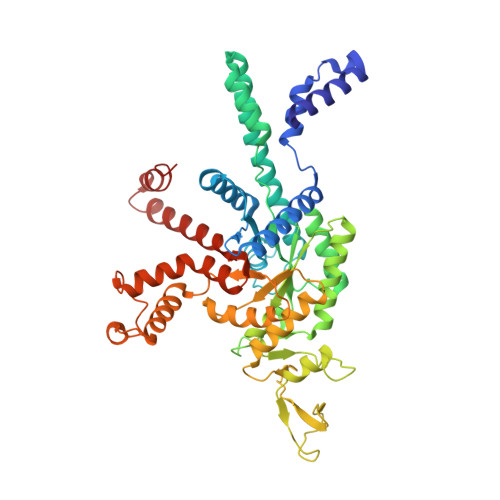Gluconeogenic precursor availability regulates flux through the glyoxylate shunt inPseudomonas aeruginosa.
Crousilles, A., Dolan, S.K., Brear, P., Chirgadze, D.Y., Welch, M.(2018) J Biological Chem 293: 14260-14269
- PubMed: 30030382
- DOI: https://doi.org/10.1074/jbc.RA118.004514
- Primary Citation of Related Structures:
5M2E, 6G1O, 6G3U - PubMed Abstract:
The glyoxylate shunt bypasses the oxidative decarboxylation steps of the tricarboxylic acid (TCA) cycle, thereby conserving carbon skeletons for gluconeogenesis and biomass production. In Escherichia coli , carbon flux is redirected through the first enzyme of the glyoxylate shunt, isocitrate lyase (ICL), following phosphorylation and inactivation of the TCA cycle enzyme, isocitrate dehydrogenase (ICD), by the kinase/phosphatase, AceK. In contrast, mycobacterial species lack AceK and employ a phosphorylation-insensitive isocitrate dehydrogenase (IDH), which is allosterically activated by the product of ICL activity, glyoxylate. However, Pseudomonas aeruginosa expresses IDH, ICD, ICL, and AceK, raising the question of how these enzymes are regulated to ensure proper flux distribution between the competing pathways. Here, we present the structure, kinetics, and regulation of ICL, IDH, and ICD from P. aeruginosa We found that flux partitioning is coordinated through reciprocal regulation of these enzymes, linking distribution of carbon flux to the availability of the key gluconeogenic precursors, oxaloacetate and pyruvate. Specifically, a greater abundance of these metabolites activated IDH and inhibited ICL, leading to increased TCA cycle flux. Regulation was also exerted through AceK-dependent phosphorylation of ICD; high levels of acetyl-CoA (which would be expected to accumulate when oxaloacetate is limiting) stimulated the kinase activity of AceK, whereas high levels of oxaloacetate stimulated its phosphatase activity. In summary, the TCA cycle-glyoxylate shunt branch point in P. aeruginosa has a complex enzymology that is profoundly different from those in other species characterized to date. Presumably, this reflects its predilection for consuming fatty acids, especially during infection scenarios.
- From the Department of Biochemistry, University of Cambridge, Tennis Court Road, Cambridge, CB2 1QW, United Kingdom.
Organizational Affiliation:


















